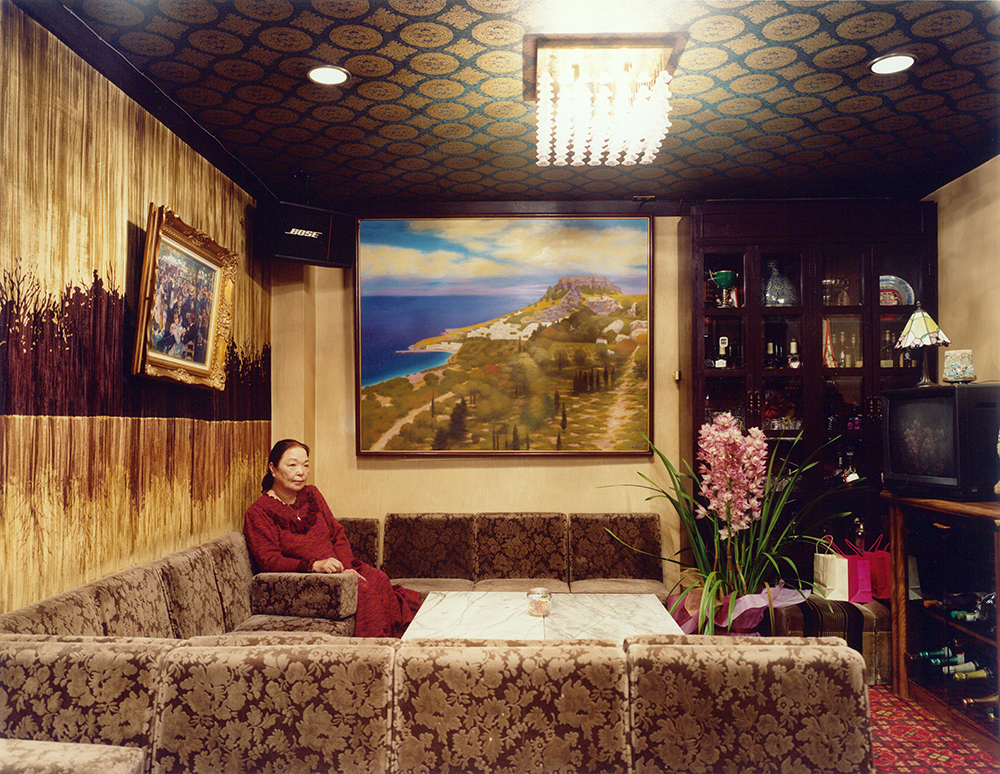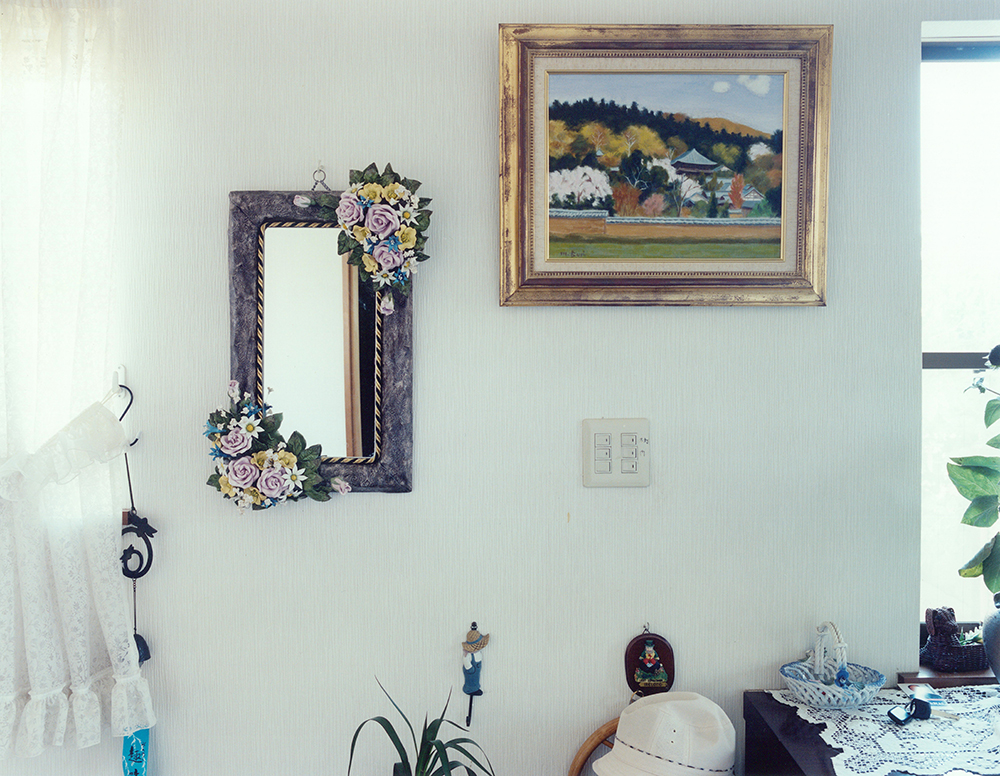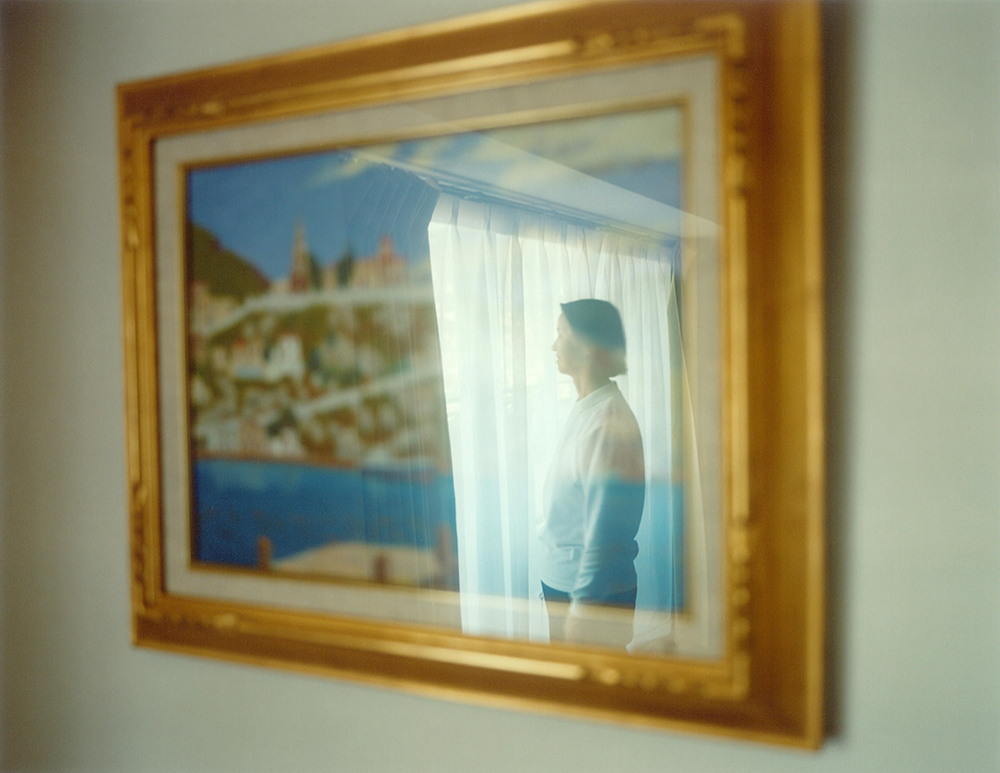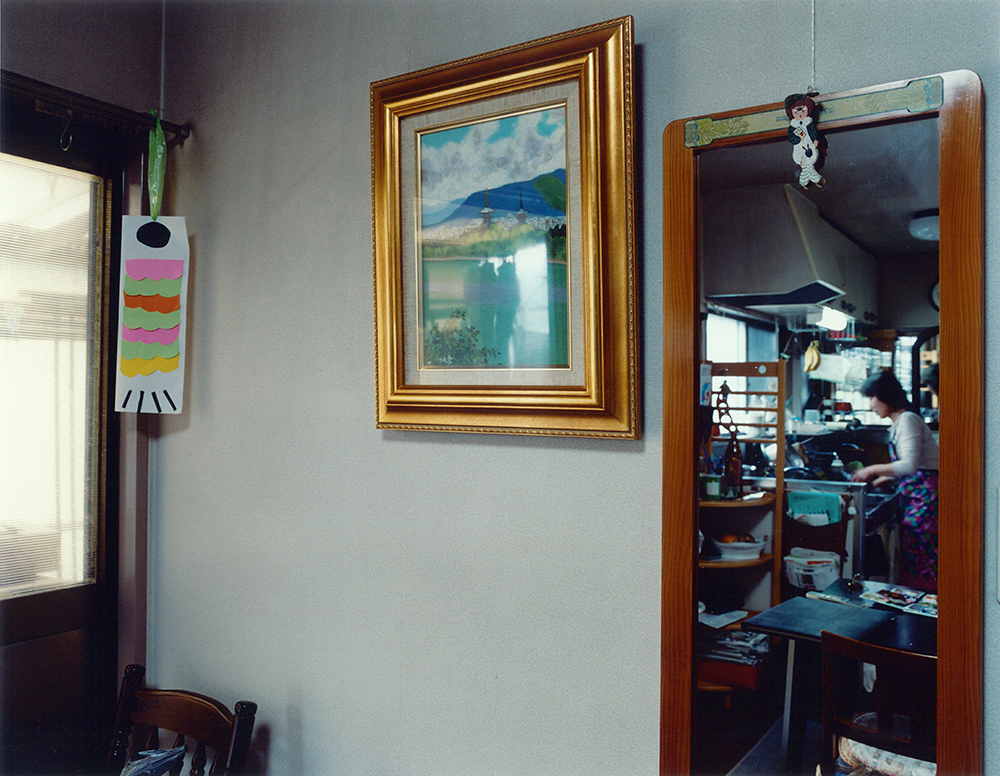2006 – 2010
祖父はよく旅をして絵を描いた
祖父が描いた絵をさがす旅に出た
My grabdfather traveled and painted a lot.
I made a trip after his paintings.

ママ
ウチのお店、町のお偉いさんがずいぶん来るんやけど、みんな飲んだら普通のおっちゃん。
みんな「ママ~、ママ~」言うてくんねん、子供みたいでかわいいでぇ。
この絵、よぉお客さんから「誰の絵なん?」て聞かれるんやけど、
私、おじいちゃんに会うた事ないやろ。
そやから「友達のお父さんの絵やねん」て答えてるんやわぁ。
そしたら今度、「これどこの風景やの?」て聞かれるやろ、
それもよう知らんから「たぶん日本とはちゃうなぁ…」言うて、いっつもごまかすんや。
この絵のこと、何もしらんなぁ。はははっ。
少し前まで、ウチにあったおじいちゃんの別の絵、町役場の重役さんが気に入ってなぁ。
無理や言うてんのに、「地元の風景の絵やし、絶対欲しい!」て。
今は役場の部屋に飾ってあるんよ。
おじいちゃん、えらい紳士やったらしいし、会いたかったわぁ~。
Mama
My pub is visited by many people.
for example, policemen, firemen, and many important people of my town.
Whenthey drink, they become common folk.
Then they look like my children, they are youthful and sweet.
Many visitors asked me “Who painted this picture?”.
Then I answer “My friend painted it”< because I hadn’t met him.
Next, VIsitors often asked me “Where is the land scape in this picture?”.
I dodge this question “Maybe… this is not Japan”, becouse Ididn’t know about it.
I don’t know any this picture, hahaha…
Now I remember, often the direcotor of town office came to my pub.
One day hetook the other picture that i had prior to this one.
He said “I want this picture, because it’s drown our town!”.
Now That picture is displayed at his office.
I wanted to meet your grandfather just once…
because people say “He was such a gentlemen”.

妻の妹の夫
この絵はねぇ…、大阪からこっちに引っ越して来た時にもろたから、もう20年くらいはこの玄関にあるねぇ。
後ろからの東大寺の絵って珍しいやろ?
大阪に住んでるころ、ハイキング行ったら、東大寺の裏山からの景色が良うてなぁ。にいさんにそれを話したら「ほんなら、行ってみるわ」いうてね。この絵をすぐに描いてくれたんです。
あの頃、にいさん元気やったから、バイクでいろんなとこ走り回っとったな。
A husband of his wife’s sister
Let’s see… I got this painting when I moved from Osaka, so that makes it like 20 years by now that we have it in the entrance.
Don’t you think it is kind of unusual to paint the backside of Todaiji-temple?
Back in those days when I was still living in Osaka, I visited Todaiji-temple, and found that a view from backside hill was great.
When I told him about it, he said “Then, I will go see it,” and came back and painted it right after.
He went around many places with his motorcycle in those days.

娘
お父さんのアトリエを取り壊すとき、棚や倉庫にホントにたっくさんの絵が残っとってなぁ。
うちにも結構持って帰ってきたし、ええなぁと思う絵は親戚や友達に送ったんよ。ただ、ホントたくさん絵あってなぁ…。
全部は持って帰れんぶんは、最終的には廃棄業者に持っていってもらったんよ。もったいないことしたなぁ…。
まだウチにもたくさんの絵があるでしょ。たまに人にあげてるから、これでもずいぶん数減ったたけど、15枚くらいくらいかなぁ。
季節に合わせて、「この部屋の夏はこれ!」って、絵を掛け変えれるくらいは残しとかんとね。
His daughter
We found a lot of his paintings on the shelf and in the storage when we pulled down my father’s studio.
I took many of them to our home, and also sent the good ones to his relatives and friends.
But you know, there were so many…so I needed to make a decision to throw some of them that had nowhere to go…
I still regret that.
Even though I keep giving it away to people, I guess we still have lots of them at home. Maybe around 15 or so?
I think I’d like to keep enough to change the paintings in each room in every season.

娘婿の姉
おじさんとはもう長いこと会ってなかったけど、テレビ見ていて「アタックチャンス」の児玉清を見る度に、今でも主人とおじさんのことを思い出すんです。 少し似てない?
おじさんの個展に絵を見に行ったこともあるし、毎年おじさんから手彫りの版画入りの素敵な年賀状が届きました。だからいつか絵が欲しいなぁと前から思ってたんです。結局、おじさんが亡くなられて、家を壊す時に、たくさんの絵が残っていると聞いたので、何枚か絵をいただくことになりました。
この海辺のブルーの油絵は、すごく気に入って玄関に飾っています。絵をもらったときに、「この絵は玄関だ!」って思ったんです。実はこの絵が来るまでは、この壁にはモネの睡蓮の絵のコピーが飾ってあったんですよ。
The elder sister of his son-in-law
I haven’t seen my uncle for long time, but every time I watch the TV quiz show ‘ATTACK CHANCE’ and see the actor Kiyoshi Kodama, I remember both my husband and him. Don’t you think they look similar?
I saw his paintings at his solo exhibitions, and every year he sent me a new years card which was a woodcut print. So I’ve wanted to own one of his work one day. When he passed away, his house was going to put down, and then, Somebody told me that there are a lot of paintings left in the house. So I went there and picked up some for myself.
This blue seaside oil painting is my favourite one and that’s why I hang in the doorway. I immediately thought “Yes, this should be at the entrance!” when I got it. There was a fake copy of Monét’s ‘Water lilies’ before that.

ご近所さん
フジカワさんと出会ったんは、地元の自治会の当番の時やね。
静かなおじいちゃんやったけど、ある時自治会の話し合いで「助成金を値上げしてくれ!」って言い寄ってきたおっちゃんがおってな。そん時フジカワさんが「自分で遊ぶ金くらい自分で出したらええねん!」って言ったら、みんなから拍手がおこってなぁ。カッコエエおじいちゃんやなぁて思って、帰り道で呼び止めて、一緒に近所まで帰ったんよ。そやから、私がナンパしたんやなぁ。(笑)
この絵は、あなたのお母さんがくれたんよ。
色きれいやし、奈良の雰囲気でとるし、いい部屋に飾ったらもっと栄えると思うんやけど、ウチには飾るとこないんよ。家建て替えんととあかんなぁ。
でもおばちゃん、台所にいる時間が多いから、ここに飾ってあると、いつもボケッと眺められるんよ。
His neighbour
Well, I met Mr. Fujikawa at a town meeting.
He was a quite an old man. In one of the town meetings some old folk cried out, “We need more funding!”, he yelled back at him, “Can’t you afford even your spending money, huh?”, and everybody applauded. I thought he was so cool, and caurht him on the way home and we walked back to the neighbourhood together. Sure, you could say that I flirted with him.
You know, it was your mother who gave this painting to me.
I think the colour is good, and it really shows how Nara is like. I think it would look better in a better room, but there is no such space in my house. I should rebuild this house, perhaps.
But if it’s hung here, it’s good. I can see it at any time because I spend lots of time in the kitchen every day.
物語となった記憶
考古学者になりたかった下道少年は、カメラをもったアーティストになった。だが、感心を寄せる対象は少年時代とそれほど変わっていないとみえる。下道基行は、特有の歴史や記憶が有形無形に遺る場を訪れ、その場や物がたずさえる人々の記憶を取材し、写真に納め、ときにそれについて書くことを作品としている。題材は社会的なものから個人的なものまでと幅があるが、自分の足で歩き自らの五感で確認し、その場や物に留まる記憶に直にコンタクトする実地調査の手法は共通している。
国内に遺る戦争遺跡や旧占領地に建てられた鳥居を追跡調査してつくった他の作品に比べると、私的な性質が際立つ本作《日曜画家/Sunday Painter》は、日曜画家だった祖父の遺した油彩を下道本人が訪ねつくった、写真とお手製の本からなるシリーズ作品だ。
だが、不思議なことに、これらの写真は祖父の遺した絵を主題としながらも、必ずしもその肝心の絵に焦点があわされていない。絵はときに構図の中心から外され、ピントがあっていないものさえある。撮影者の視点は、祖父の絵というよりむしろ、絵の持ち主である人や、その人の営みがうかがえる部屋へ向けられている。下道が写真を通して本作でとらえているのは、つまり、絵そのものではなく、その周辺にあるものであり人であるといえる。
一方、写真と対につくられた本は、下道が絵のもらい手たちから聴取した、祖父にまつわるさまざまな記憶に焦点をあてている。下道は、語られた記憶を話し手の口調やなまりをそのままに残し、口語体で文章化した。語り口調がいかされた文章の書き方は、取材した素材に忠実な記述であるという印象を読み手に与える。だが、私たちが目にするのは、語られた言葉のなかから下道が取捨選択したものにほかならない。記憶は編集されるとしばしば言われるように、事実のある部分は無意識的に誇張され、また別の部分は忘却される。本作で絵の持ち主が語った記憶もその例外ではないだろう。言い換えれば、この本は、「記憶」という名のもとに語られた脚色された事実を、下道がさらに編集して仕上げた、一種の「物語」なのである。
人の主観によって知らず知らずのうちに変容する歴史や記憶。下道の視点の先にあるのは、有形の遺跡や遺品そのものではなく、潜在意識下で変形し、もとの形を失ってぼんやりとしている記憶ではないだろうか。下道が本作を通して行ったことのひとつは、過去から現在へと至る間にズレや歪みをうみ「かたち」の定まらなくなった記憶に改めて「かたち」を与えること、そして個々人のなかにかすかに残る逸話を引き出し、物語へと整えたことである。
祖父の絵を追うという自ら定めたルールにそって、下道が人びとを訪ね、彼/彼女らの記憶を収集し編集した《日曜画家/Sunday Painter》は、「かたち」を与えられた記憶を通じて、どこか懐かしい身近な物語を見る者に伝える。すると、似たような想い出が鑑賞者の内奥からも呼び出され、それに付随する逸話が浮かび上がってきはしないだろうか。もしそうだとすれば、自らの「記憶」という名の「物語」に耳を傾けてみるのも一興だ。
竹久侑(水戸芸術館現代美術センター学芸員)
“Memories transformed into stories”
Shitamichi Motoyuki, who wanted to become an archeologist when he was young, has now become a camera-toting artist. The things that captured his interest as a boy, however, seem not to have changed much. Shitamichi visits places where trace of specific histories and memories remain, in forms that are both tangible and intangible. He interviews the people associated with a particular place or object, collecting information about their memories and recording the results of his research in the form of photographs, occasionally presenting his own thoughts and musings on these topics as part of his work. the subject of his research ranges from social themes to individual anecdotes, but what all of Shitamichi’s work shares in common is its field study approach: first-hand investigations that consist in verifying facts using his own senses, and making direct contact with the memories that lie embedded in places and objects.
Compared with other works that emerged as a result of follow-up investigations of war ruins in Japan and torii gates (typically found at the entrance to Shinto shrines) in Japan’s former territories, “Sunday Painter” has a conspicuously personal tone to it. Comprising several photos and a handmade book, this series was created after several visits spent tracking down some oil painting left behind by his grandfather, an amateur artist.
Curiously enough, however, although the subjects of these photos are the works left behind by his grandfather, their focus is not always on the paintings. In some of photos, the paintings are removed from the center of the composition, and others are even somewhat unfocused. The photographer’s gaze appears to be trained not so much on paintings, but rather on their current owners and the rooms that reveal something about their lives. In other words, what Shitamichi captures in this work through his photographs is the things and people that surround these paitings.
The book that accompanies the photographs, on the other hand, focuses on the rich variety of memories related to Shitamichi’s grandfather that were told to him by the recipients of the paintings. Transcribed into stories written in a colloquial style, the recounted memories retain the accent, tone of voice and expressions unique to each person. Shitamichi’s style of writing, which makes use of the distinctive voice of each speaker, gives the reader the impression that this is a faithful rendering of the material that was collected during his research. What we see, however, is nothing but a selective part of what was actually recounted to the artist. Just as memory is often said to be edited, elements with any truth to them become unconsciously exaggerated, while other parts are completely forgotten about. The memories recounted by the owners of the paintings in the work, as it turns out, are no exception. To put it another way, this book is a kind of “story” based on dramatized truths, recounted in the form in the form of “memories” that Shitaimichi father edited and polished.
History and memory are often transformed by human subjectivity without us ever being aware of it. Shitamichi’s gaze is trained not on the tangible remnants or concrete traces left behind by history, but rather the things that undergo a metamorphosis, losing the contours of their from and becoming only a vague recollection in our subconscious. One of the things that he has done through this work is to restore a semblance of from to memories that have been shifted or distorted in the interval between the past and the present and become misshapen, so to speak. In so doing, Shitamichi teases out anecdotes whose faint traces still remain in the minds of these individuals, and reworks them into stories.
For “Sunday Painter,” Shitamichi set himself the task of tracking down his grandfather’s painting. by paying visits to the owners of the paintings to collect their memories, he transformed them into his own work through the act of editing. These recollections, which have recovered some sort of “shape” thanks to Shitamichi, recount to the viewer stories that are somehow nostalgic and familiar. Similar memories are evoked in the deepest recesses of the viewer’s mind-and along with them, perhaps the anecdotes attached to those memories will also start to rise to the surface. If they do, perhaps the viewer will find his/her own joy in listening to the stories that their own so-called memories have been transformed into.
Yuu Takehisa (curetor, Contemporary Art Center, Art Tower Mito)
